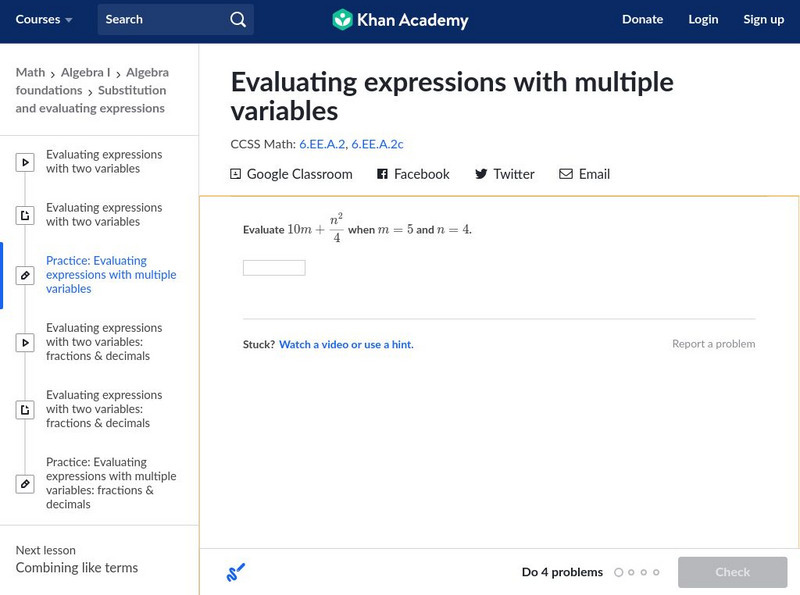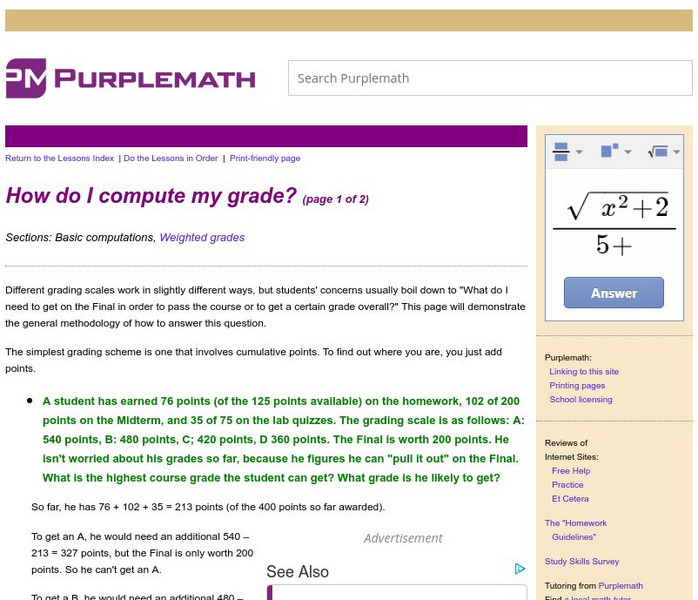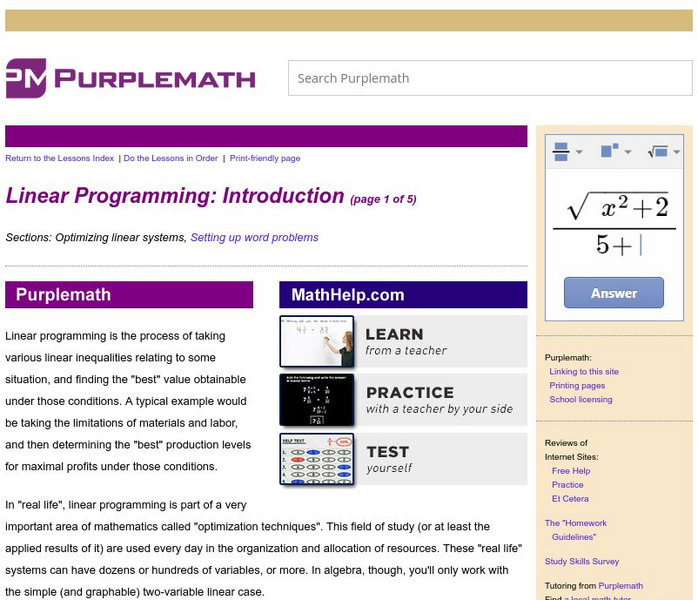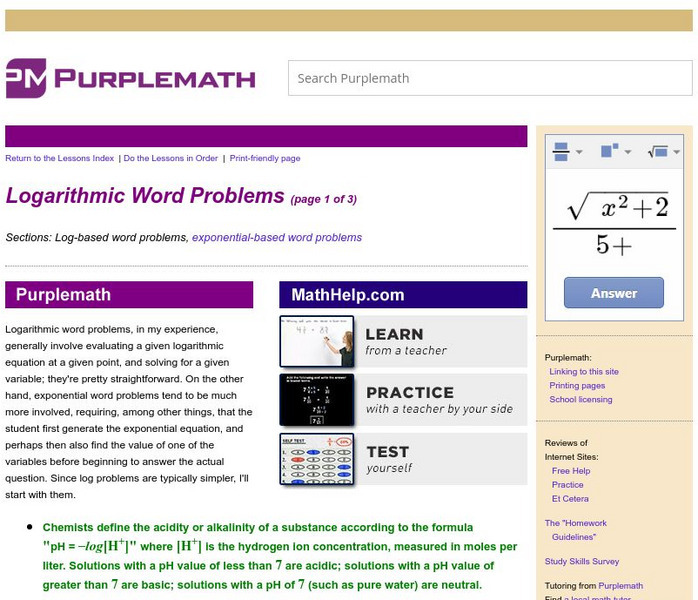University of St. Andrews (UK)
University of St. Andrews: Biography of Jacob Bernoulli
The School of Mathematics and Statistics of St. Andrew's University provides biographical information on the mathematical career of Jacob Bernoulli. Included are links to other famous individuals with whom he worked and links to his...
University of St. Andrews (UK)
University of St. Andrews: Pierre Simon Laplace Long Biography
Contains a long detailed biography of Pierre-Simon Laplace.
University of St. Andrews (UK)
University of St. Andrews: Pierre De Fermat
This site, which is provided for by the University of St. Andrews, gives biographical information on mathematician Pierre de Fermat.
University of St. Andrews (UK)
University of St. Andrews: Leonhard Euler
Biography of mathematician Leohnard Euler, who introduced the concept of beta and gamma functions.
University of St. Andrews (UK)
University of St. Andrews: Thomas Bayes
Biographical information on Thomas Bayes, mathematician who worked on the theory of probability.
University of St. Andrews (UK)
University of St. Andrews: Christoff Rudolff
This site from the University of St. Andrews provides biographical information about mathematician Christoff Rudolff, author of the first book about algebra in German.
University of St. Andrews (UK)
University of St. Andrews: George Dantzig
This site, which is provided for by the University of St. Andrews, gives a biography of mathematician George Dantzig, the man that introduced the concept of linear programming.
Purple Math
Purplemath: Function Transformations
Generally, translation involves only moving the graph around. Squeezing or stretching a graph is more of a "transformation" of the graph. But these two topics are usually taught at the same time, and usually under the same name. Just be...
Khan Academy
Khan Academy: Equivalent Expressions
Practice determining whether or not two algebraic expressions are equivalent by manipulating the expressions. These problems require you to combine like terms and apply the distributive property. Students receive immediate feedback and...
Khan Academy
Khan Academy: Practice: Writing Basic Expressions With Variables
Practice writing basic algebraic expressions to match verbal descriptions of mathematical operations. Students receive immediate feedback and have the opportunity to try questions repeatedly, watch a video or receive hints.
Khan Academy
Khan Academy: Two Step Inequalities
Solve inequalities that take two steps to solve. For example, solve 3x + 2 > 5. Students receive immediate feedback and have the opportunity to try questions repeatedly, watch a video or receive hints.
Khan Academy
Khan Academy: Two Step Inequality Word Problems
Practice constructing, interpreting, and solving linear inequalities that model real-world situations. Students receive immediate feedback and have the opportunity to try questions repeatedly, watch a video or receive hints.
Khan Academy
Khan Academy: One Step Addition & Subtraction Equations: Fractions & Decimals
Practice solving equations in one step by adding or subtracting a number from both sides. These problems involve decimals and fractions. Students receive immediate feedback and have the opportunity to try questions repeatedly, watch a...
Khan Academy
Khan Academy: Two Step Equations Word Problems
Practice writing equations to model and solve real-world situations. Students receive immediate feedback and have the opportunity to try questions repeatedly, watch a video or receive hints.
Khan Academy
Khan Academy: Multi Step Equations Review
To solve an equation find the value of the variable that makes the equation true. For more complicated equations, this process can take several steps.
Khan Academy
Khan Academy: Linear Equations Word Problems: Tables
Solve word problems about real world relationships that are given in tables. Students receive immediate feedback and have the opportunity to try questions repeatedly, watch a video or receive hints.
Khan Academy
Khan Academy: Evaluating Expressions With Two Variables
Practice evaluating expressions in two variables by plugging in values for the variables. Students receive immediate feedback and have the opportunity to try questions repeatedly, watch a video or receive hints.
Purple Math
Purplemath: How Do I Compute My Grade?
Demonstrates how to figure out what you need on the Final to pass your course, given a typical grading scheme.
Purple Math
Purplemath: Linear Programming: Introduction
Linear programming is a part of a very important area of mathematics called "optimization techniques". This field of study (or at least the applied results of it) are used every day in the organization and allocation of resources. Linear...
Purple Math
Purplemath: Logarithmic Word Problems
Logarithmic word problems generally involve evaluating a given logarithmic equation at a given point, and solving for a given variable; they're pretty straightforward. This resource contains worked examples to demonstrate the reasoning...
Purple Math
Purplemath: Mean, Median, Mode, and Range
Mean, median, and mode are three kinds of "averages". The "mean" is the "average" you're used to, where you add up all the numbers and then divide by the number of numbers. The "median" is the "middle" value in the list of numbers. To...
Purple Math
Purplemath: Matrix Inversion: Finding the Inverse of a Matrix
Inverse matrices are very useful for solving matrix equations. But, given a matrix, how do you invert it? How do you find the inverse? The technique for inverting matrices is kind of clever. For a given matrix A and its inverse A-1, we...
Purple Math
Purplemath: Partial Fraction Decomposition: General Techniques
Partial-fraction decomposition is the process of starting with the simplified answer and taking it back apart, of "decomposing" the final expression into its initial polynomial fractions. This reference material demonstrates the...
Khan Academy
Khan Academy: One Step Multiplication & Division Equations
Based on our understanding of the balance beam model, we know that that to keep a true equation, we always have to do the same thing to both sides of an equation. But how do we know what to do to both sides of the equation? Learn to...

























